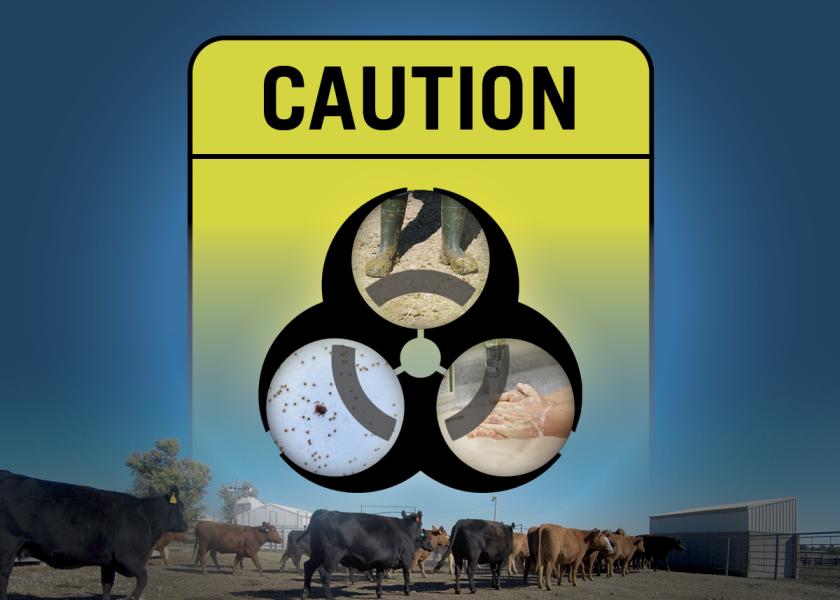Biosecurity in the cattle industry has experienced emerging challenges in recent months, and veterinarians have been on the forefront of the response. Influenza A (H5N1) virus has been found in dairy herds in at least 13 states and has altered animal movement across the country.
Another threat is the Asian Longhorned Tick, which has expanded its range to include beef cattle in the Midwest. These looming risks present cattle veterinarians and producers with an opportunity and a challenge to improve biosecurity practices to protect animal health and welfare, human health and business continuity.
Veterinarians are uniquely trained to evaluate individual animals within a herd system and provide integrative management plans to prevent diseases or problems from occurring in the future. These plans and protocols promote animal health and minimize the time and labor resources required to treat sick animals.
Small steps can reduce disease transmission probability by orders of magnitude. Simple measures such as hand washing, changing coveralls, and cleaning boots can have a great impact on disease transmission. Foundational principles of biosecurity, as discussed in the Beef Quality Assurance (BQA) program, funded by the Beef Checkoff, are necessary to build upon and understand where a particular cattle operation stands at present.
Reduce Disease Risks
Annual biosecurity training for caretakers and visitors in disease prevention and control practices can reduce the risk of disease spread between animals and humans (zoonotic disease) and prioritizes public health for all. Proper implementation of sound biosecurity practices can also protect the operation from lawsuits and financial loss.
Biosecurity planning is a proactive prevention practice that veterinarians and producers can work on together. It overlaps with many aspects of the herd health plan, including quarantining new animals, assessing movement records, updating treatment records and animal identification, providing good nutrition, optimizing welfare, minimizing stress with good stockmanship, and implementing vaccination programs. These topics encompass everyday activities and veterinarians have a critical teaching role in caretaker education regarding biosecurity guidelines.
Daily biosecurity practices include some of the most important steps to protecting the cattle herd. Veterinarians can assist producers in customizing plans for each operation, allowing flexibility for producers and their resource team to evaluate what management practices work best for their situation. BQA has partnered with the USDA-funded Secure Beef Supply (SBS) Plan for Continuity of Business to develop resources on how to properly develop written biosecurity plans to effectively combat common cattle diseases.
The BQA Daily Biosecurity Plan for Disease Prevention template offers an introductory, stepwise biosecurity plan for identifying and mitigating biosecurity risks on cattle operations.
Additional Precautions
This daily plan is a precursor to the SBS Plan, an enhanced biosecurity plan which will be necessary during a potential or confirmed foreign animal disease outbreak such as with foot and mouth disease (FMD) which is the most contagious viral disease that affects cloven-hooved animals. The SBS plan and training materials have amplified biosecurity steps to protect against FMD.
The SBS plan is similar to other Secure Food Supply plans, such as the Secure Milk Supply (SMS). As the dairy industry continues to be impacted by H5N1, USDA is reimbursing producers who want to develop an enhanced biosecurity plan using SMS resources. Veterinarian involvement is key to implementing biosecurity at the farm level.
All producers will start their biosecurity plans at different levels, so emphasizing foundational biosecurity principles will be advantageous during plan development. The National Cattlemen’s Beef Association (NCBA), through USDA National Animal Disease Preparedness and Response Program (NADPRP) funds, has been developing new SBS educational resources including sector specific videos as training tools. See Table 1 for new resources that have been developed through this project. National train-the-trainer workshops for veterinarians will also be offered at AABP and winter AVC meetings to educate and encourage adoption of the SBS Plan.
The greatest contribution of the cattle (and livestock) industry to disease preparedness will include proactive preparation through biosecurity planning. Collaboration among all levels of the supply chain will be vital as we continue to protect the integrity of our cattle and livestock industries.
Secure Beef Supply and BQA Biosecurity Resources
- Enhanced Biosecurity Supply List for Cattle Operations
- Livestock Hauler/Transporter Enhanced Biosecurity Steps
- Contingency Planning for Livestock Haulers/Transporters
- What to Expect During a National Movement Standstill
- Premises Identification: What is needed and how is it used?
- Creating a Premises Map Video & corresponding instructions handout
- Customizable outreach articles for “What producers need to know about SBS” (250-, 500-, 1,000-word articles available)
For more information and downloadable preparation documents, visit:
- Beef Quality Assurance
- Secure Beef Supply Plan
- For veterinarians in the dairy industry, the National Dairy FARM program has an extensive biosecurity program
This article was written by Dr. Julia Herman, DVM, MS, DACVPM, Beef Cattle Specialist Veterinarian, NCBA, a contractor to the Beef Checkoff.
SOURCE: Drovers By NCBA August 19, 2024
PHOTO: Farm Journal








